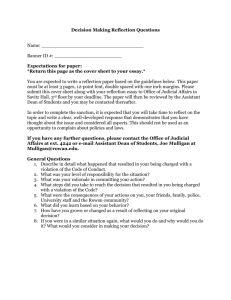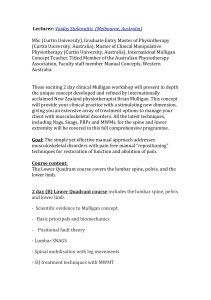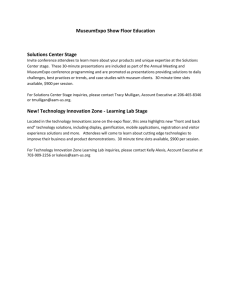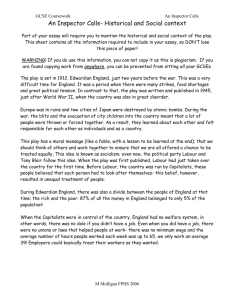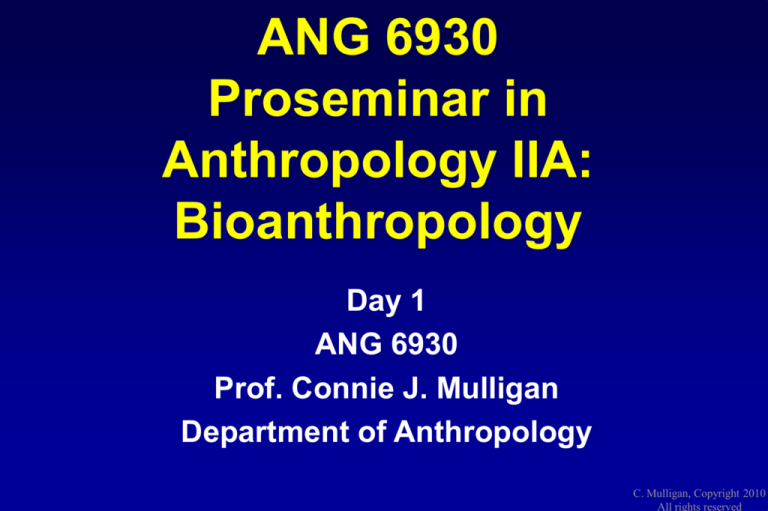
ANG 6930
Proseminar in
Anthropology IIA:
Bioanthropology
Day 1
ANG 6930
Prof. Connie J. Mulligan
Department of Anthropology
C. Mulligan, Copyright 2010
All rights reserved
• Did everyone receive my email before
Christmas?
• Does everyone have the textbook?
• Does everyone have the coursepack or access
to the articles?
• Has everyone done the readings for today?
C. Mulligan, Copyright 2010
All rights reserved
Introductions
C. Mulligan, Copyright 2010
All rights reserved
My interdisciplinary research
• Current research
– Genetic, biological, and cultural determinants of cardiovascular disease,
hypertension, and stress
• Lance Gravlee, cultural anthropologist, UF
– Epigenetic alterations and stress among new mothers and infants in the
Democratic Republic of Congo
• Nikki D’Errico, Lance Gravlee and Alyson Young, cultural anthropologists, UF
– Emergence of anatomically modern humans from Africa and subsequent
contacts across the Red Sea
• Steve Brandt and Peter Schmidt, archaeologists, UF
• Past research
– Phylogenetic analysis of Semitic languages to compare to phylogenetic
analysis of DNA from Semitic populations
• Chris Ehret, linguist, UCLA
– Transmission of HIV from mother to infant through breastfeeding
• Maureen Goodenow, molecular geneticist, UF College of Medicine
– Genetic variants that affect risk of developing alcoholism
• David Goldman (NIH) and Jeff Long (U Mich) – molecular/population geneticists
C. Mulligan, Copyright 2010
All rights reserved
Course materials
• One textbook (Orange & Blue Textbooks, 309 NW
13th St)
– The Human Species: An Introduction to Biological
Anthropology (2010, Eighth edition) by John
Relethford
• Course packet (Orange & Blue Textbooks, 309 NW
13th St)
– Journal articles
• Some figures don’t copy well – go to original source through
e-journals
– Especially important for color figures
– Chapters from other textbooks
– Newspaper articles
C. Mulligan, Copyright 2010
All rights reserved
Course schedule
First half of the course = Bioanthropology
•
•
•
•
•
•
•
Day 1 – Introduction and overview of the discipline
Day 2 – Science and evolution
Day 3 – Genetics and the development of evolutionary theory
Day 4 – Primate evolution, ecology and behavior
Day 5 – Human evolution – hominoid to hominin
Day 6 – Origin of modern humans/human variation
Day 7 – Evolution of human life history/evolution of human
intelligence and complex phenotypes
Second half of the course = Archaeology
C. Mulligan, Copyright 2010
All rights reserved
Course content
•
•
•
•
•
Evolutionary theory and genetics
Primates and our place in nature
Human evolution
Human variation
Culture and behavior in an evolutionary context
C. Mulligan, Copyright 2010
All rights reserved
Course format
•
•
•
•
Quizzes (every other week, starting next week)
Lecture
Class discussion
ALWAYS ask questions!!!
C. Mulligan, Copyright 2010
All rights reserved
Contact information
• Prof. Connie Mulligan
– cmulligan@ufl.edu
– 273-8092
• Office hours – B119 Turlington, Friday, 10:30-12:30
• My main office – 409 Genetics Institute, 1376 Mowry Rd, 273-8092
• Course webpage -
http://www.clas.ufl.edu/users/cmulligan/Webpage/P
roseminar.2011/Prosemhome.html
• Can also go through anthro homepage
(www.anthro.ufl.edu)
– syllabus, lectures, answers to quizzes, etc
• PP presentations also at
www.clas.ufl.edu/users/mulligan/Pub/ANG6930
C. Mulligan, Copyright 2010
All rights reserved
Grading policy
I assign 50% grade for course
• Participation – 100 pts
–
–
–
–
Punctuality is important – arrive to class on time
Come prepared with questions and comments, etc
Ask questions – not expecting geniuses
You must talk in class – no points for attendance
• No talking = 0 points for 25% grade in 1st half of class
• Weekly quiz or comments/questions – 100 pts
• Journal analysis – 100 pts
• Exam – 100 pts
C. Mulligan, Copyright 2010
All rights reserved
Grading policy
• Participation – 100 pts
• Weekly quiz or comments/questions – 100 pts
- 3 quizzes – 2-4 short answer/essay questions on reading
material
- Every other week, starting next week
- 3 original comments/questions on reading material
- Alternate weeks from quizzes
- Develop good practices for reading journal articles
- Don’t copy directly from articles – you must put the information in your
own words
- Turn in at beginning of class
- Lowest grade will be dropped
• Journal analysis – 100 pts
• Exam – 100 pts
C. Mulligan, Copyright 2010
All rights reserved
Questions/Comments
• Must be handed in at beginning of class
• Purpose of Questions/Comments
–
–
–
–
Ensure you read required assignments
Ensure you have comments if I call on you
Grading material – have you done the reading, understood it, thought about it?
I won’t answer your questions when I grade them – ask them in class
• Expect something more than “What is X?”
– Look it up in a dictionary
• A question is fine, but tell me why you’re asking it, what you’ve
already thought about it, what questions it leads to, etc
• Comments should be based on what you’ve read and taken a step
further
• Try to submit a question/comment on each reading assignment
– Identify reading material
– More is always better
• Typically get very good questions, but students don’t ask them in
C. Mulligan, Copyright 2010
class
All rights reserved
Grading policy
• Participation – 100 pts
• Weekly quiz or comments/questions – 100
pts
• Journal analysis – 100 pts
– Details on webpage http://www.clas.ufl.edu/users/cmulligan/Webpage/Pro
seminar.2011/Journal%20analysis.htm
– Important deadlines
• Jan 21 – topic and abstract (<200 words) due
• Feb 18 (last day of class) – final paper due (~10 pages,
double-spaced)
• Exam – 100 pts
C. Mulligan, Copyright 2010
All rights reserved
Journal analysis
• Select a topic and systematically track research on this topic in
biological anthropology and (at least) one other subfield of
anthropology (through peer-reviewed journals).
• You will examine how a topic of interest to you has been covered in
the last 15 years in five leading, peer-reviewed bioanthropology
journals
– Must include American Journal of Physical Anthropology, American
Anthropologist, and Current Anthropology
– Choose two additional journals that are appropriate for the topical focus of
your review, e.g. American Journal of Human Biology, Journal of Human
Evolution, American Journal of Human Genetics, International Journal of
Osteoarchaeology, International Journal of Primatology. The two additional
journals do not have to be bioanthropology journals.
– Most of these journals are available online, although some do not go back as
far as 15 years through the online access and you will have to go to the
library to see the hard copies
– A good way to search for articles that are relevant to your topic is through
PubMed (http://www.ncbi.nlm.nih.gov/entrez/query.fcgi?DB=pubmed)
C. Mulligan, Copyright 2010
All rights reserved
Journal analysis, cont
• Once you choose your topic, you will write a paper (~10
pages, double-spaced) that discusses how your topic
was addressed in the five journals over that past 15 years
– An important point will be to examine how bioanthropology and
another subfield of anthropology cover your topic, e.g. what are
the important questions being addressed/hypotheses being
tested, what are the interpretations and conclusions, are there
major differences in interpretations/conclusions?
– Your topic (the relevant question(s) and which other subfield
you will be examining) and an abstract (<200 words) of your
search strategy (which journals are you using and why) is due at
the beginning of class on Jan 21.
• In your abstract, be sure to specify your two additional journals, and why
you chose them, as well as the other subfield of anthropology that you
will be studying. I encourage you to discuss your topic with me in
advance, in person or by email.
– The final paper is due at our last class, Feb 18 (plus original
abstract).
C. Mulligan,
Copyright 2010
All rights reserved
Journal analysis, cont
• The purpose of this exercise is to:
– Introduce you to the major journals
– Improve your ability to conduct literature reviews
– Enhance your skills in identifying a research problem
– Identify patterns across subfields, as well as the
potential strengths and weaknesses of a four-field
anthropology.
C. Mulligan, Copyright 2010
All rights reserved
Grading policy
• Participation – 100 pts
• Weekly quiz or comments/questions – 100
pts
• Journal analysis – 100 pts
• Exam – 100 pts
– Take-home exam
– You can use any resource and can discuss exam
with classmates, but answers must be your own
– Short answer similar to quizzes and one essay
question
– Due last day of class
C. Mulligan, Copyright 2010
All rights reserved
Plagiarism
• What is plagiarism?
– To steal or pass off the ideas of another as one’s own
• Check out these webpages
– http://web.uflib.ufl.edu/msl/07b/studentplagiarism.html
– http://www.dso.ufl.edu/sccr/procedures/honorviolations.php
• UF’s ppt on citing refs correctly http://mediasite.video.ufl.edu/mediasite/Viewer/?peid=adaa44
500eaf460a84f238e6b9a558f9
C. Mulligan, Copyright 2010
All rights reserved
Excerpts from Babbie’s webpage
http://www.csubak.edu/ssric/Modules/Other/plagiarism.htm
• You are writing a book review of Theodore M. Porter's book, Trust
in Numbers: The Pursuit of Objectivity in Science and Public Life
and find a review by Lisa Staffen in which she makes the following
statement. Which of the following statements are examples of
plagiarism and which are not?
• Original statement – “It has become fashionable to reject the
notion of absolute objectivity on the grounds that objectivity is
simply unattainable or, even if attainable, is undesirable”
• 1) I feel it has become fashionable to reject the notion of absolute
objectivity on the grounds that objectivity is simply unattainable.
• 2) I feel it has become stylish to reject the idea of absolute
objectivity on the grounds that objectivity cannot be achieved.
• 3) Many people today have rejected the idea that there is such a
thing as absolute objectivity since they do not believe that it can
be achieved.
C. Mulligan, Copyright 2010
All rights reserved
Excerpts from Babbie’s webpage
• The following statements are examples of proper citation of
Staffen’s statement:
• 1) Lisa Staffen (1996:154) begins her review of Porter's book by
suggesting "It has become fashionable to reject the notion of
absolute objectivity on the grounds that objectivity is simply
unattainable or, even if attainable, is undesirable."
• 2) In her review of Porter's book, Lisa Staffen (1996:154) says the
idea of absolute objectivity is now commonly rejected as "simply
unattainable or, even if attainable, [as] undesirable.“
• 3) According to Lisa Staffen (1996:154), it has become fashionable
to reject the idea of absolute objectivity altogether.
C. Mulligan, Copyright 2010
All rights reserved
Plagiarism
• Bottom line – you can use other people’s ideas and
words, but you have to properly acknowledge and cite
your materials.
• The purpose is that your reader will know what material
you are borrowing and how to look up the original
source.
• Keep these guidelines in mind when writing your journal
analysis
C. Mulligan, Copyright 2010
All rights reserved
What do you get from a PubMed
search?
• Search for particular topic or author and you get a list of
relevant peer-reviewed journal articles
– Most main journals are included in PubMed
• View abstracts of all articles
• Subset of articles have pdf’s
– Freely available
– University e-subscriptions
• Often you will have to consult other sources to make
sense of the journal articles
– Specialized dictionary
– General online searches
– PubMed searches for cited articles
• If possible, read class articles or textbook while online
C. Mulligan, Copyright 2010
All rights reserved
PubMed search
• http://www.ncbi.nlm.nih.gov/entrez/query.fcgi
C. Mulligan, Copyright 2010
All rights reserved
Parts of an article
– some of this information is very field-specific and
may not be true outside Bioanthropology
•
•
•
•
What is an abstract?
What information goes into an Intro?
What information goes into Results?
What information goes into Disc?
C. Mulligan, Copyright 2010
All rights reserved
Parts of an article
• What is an abstract?
– A summary of points presented in skeletal form
– Opportunity for authors to specify what they think
are the most important points
• What information goes into an Intro?
• What information goes into Results?
• What information goes into Disc?
C. Mulligan, Copyright 2010
All rights reserved
Parts of an article
• What is an abstract?
• What information goes into an Intro?
– Background info
– Foreshadows Discussion
– All Intro material should be followed up later in article
• What information goes into Results?
• What information goes into Disc?
C. Mulligan, Copyright 2010
All rights reserved
Parts of an article
• What is an abstract?
• What information goes into an Intro?
• What information goes into Results?
– Just Results
– No interpretation, no discussion
• What information goes into Disc?
C. Mulligan, Copyright 2010
All rights reserved
Parts of an article
•
•
•
•
What is an abstract?
What information goes into an Intro?
What information goes into Results?
What information goes into Disc?
– Interpretation and significance of results
– Opportunity for authors to focus on what they think is
most important about their results
– Should pick up on info in Intro
– Can be very dependent on what topics are currently
‘hot’ so Discussion can become outdated even if
Results are still relevant
C. Mulligan, Copyright 2010
All rights reserved
How to read a journal article
• Note year of publication
– Anything more than 5 yrs old is fairly old in my field
• Note authors
– Have you read anything else by this lab?
– Author et al. Year is the best way to refer to a paper
• Refer to articles this way in Questions/Comments, Journal Analysis,
exam, etc
• General strategy for an article outside of your field
– Read Abstract, then Intro and then Disc
– M&M is usually too complicated unless you want a specific
piece of info
– Results is generally pretty cut and dried
– Re-read abstract after you read paper
• See what authors presented as the take-home message
C. Mulligan, Copyright 2010
All rights reserved
How to remember and
understand a journal article
• Take notes while reading
• Re-read article until you really understand it
• Make summary notes when you are finished reading
–
–
–
–
–
What was purpose of study?
What questions were being asked?
What were final answers?
What was unique about the study?
What is the next step?
• Write notes on paper itself or on notecards or
electronically
C. Mulligan, Copyright 2010
All rights reserved
Absentee policy
• Attendance is critical
• Quizzes/comments or quizzes can not be made up
• Journal analysis and exam will be completed on
time, no exceptions
• More info in syllabus
• And arrive to class promptly on time
C. Mulligan, Copyright 2010
All rights reserved
This week
•
•
Introduction, overview of course, bioethics
Reading
–
–
The Human Species, Chpt 1 (pp 1-12)
Course packet
–
–
–
–
–
Fuentes A. 2010. The new biological anthropology: Bringing Washburn’s
new physical anthropology into 2010 and beyond – The 2008 AAPA
luncheon lecture. American Journal of Physical Anthropology 53:2-12.
Calcagno JM. 2003. Keeping biological anthropology in anthropology, and
anthropology in biology. American Anthropologist 105:6-15.
Boas F. 1899. Anthropology. Science 9:93-96.
Spencer F. 1981. The rise of academic physical anthropology in the United
States (1880-1980): A historical overview. American Journal of Physical
Anthropology 56:353-364.
Balaresque P et al. 2007. Challenges in human genetic diversity:
Demographic history and adaptation. Human Molecular Genetics 16:R134R139.
C. Mulligan, Copyright 2010
All rights reserved
Next week
•
•
Science and Evolution
Reading
–
–
The Human Species, Chpt 1(pp 12-29) and Chpt 4
Course packet
•
•
•
•
•
Park MA. 2005. Biological Anthropology, An Introductory Reader, Chpt
9 (pp 40-44), Natural Selection (1858), Charles R. Darwin and Alfred
Russel Wallace
Mayr E. 1997. “What is science?” in This is biology: The science of the
living world, pp 24-44. Cambridge: Harvard University Press
Scott EC. 1997. Antievolution and creationism in the United States.
Annual Review of Anthropology 26:263-289
Talbot M. 2005. Darwin in the Dock. The New Yorker, pp 66-77
Berkman MB et al. 2008. Evolution and Creationism in America’s
Classroom: A National Portrait. PLoS Biology, 6:0920-0924
C. Mulligan, Copyright 2010
All rights reserved
Public lecture, Tuesday, Jan 11, 7:30,
Rion Ballroom, Reitz Union
•
•
•
•
•
•
•
Public lecture: Why Zebras Don’t Get Ulcers: Stress, Disease, and Coping, Dr. Robert Sapolsky, Tuesday, January
11, 2011, 7:30 p.m., Rion Ballroom, Reitz Union.
Dr. Robert Sapolsky of Stanford University will deliver a talk entitled “Why Zebras Don’t Get Ulcers: Stress,
Disease, and Coping” at 7:30 p.m. in the Rion Ballroom in the J. Wayne Reitz Union on the UF campus. For more
than 25 years, Sapolsky has divided his time between field work with a troop of baboons in Kenya and technical
neurological research in the laboratory. As a result, he can move effortlessly from a discussion of pecking orders
in primate societies to an explanation of how neurotransmitters work during stress---and get laughs doing it.
All first-year students in the Honors Program received a copy of Dr. Sapolsky’s book, A Primate’s Memoir, during
Preview. This book is an account of his early years as a field biologist and details the culture and political shock he
experienced. Funny, touching, and often sad and infuriating, A Primate’s Memoir gives readers insight into the
personality of a gifted scientist. Sapolsky’s lecture is based on his book, Why Zebras Don’t Get Ulcers, and
explains the findings of his research on the baboons he lived with in Africa.
Dr. Sapolsky is a MacArthur “Genius” Fellow, a professor of biology and neurology at Stanford University, and a
research associate with the Institute of Primate Research at the National Museum of Kenya. In 2008, National
Geographic & PBS aired an hour-long special on stress featuring Dr. Sapolsky and his research on the subject. In
addition to A Primate’s Memoir, which won the 2001 Bay Area Book Reviewers Award in nonfiction, Robert
Sapolsky has written three other books, The Trouble with Testosterone, Why Zebras Don’t Get Ulcers, and
Monkeyluv and Other Essays on our Lives as Animals. His articles have appeared in publications such as Discover
and The New Yorker. Dr. Sapolsky was awarded Rockefeller University’s Lewis Thomas Prize for Writing about
Science for 2008.
C. Mulligan, Copyright 2010
All rights reserved
What is biological anthropology to
you?
C. Mulligan, Copyright 2010
All rights reserved
Current hot topics on humans
• Top 10 mysteries about humans
– http://www.livescience.com/history/091026top10-origins-mysteries.html
• Top 10 things that make humans special
– http://www.livescience.com/culture/091030origins-top10-special.html
C. Mulligan, Copyright 2010
All rights reserved
Anthropology
• Important to remember that a strength of anthropology is
its holistic approach
– What’s the difference between cultural anthropology and
sociology?
– What’s the difference between biological anthropology and
biology?
• Holistic view is not limited to the 4 anthropology
subfields, but any relevant field
– Many Anthro departments are splitting along subfield lines
C. Mulligan, Copyright 2010
All rights reserved
• Why do you think more anthropological
research is not truly interdisciplinary?
– How could you make your research relevant
to someone outside your subfield?
C. Mulligan, Copyright 2010
All rights reserved
• In Fuentes’s article, he discusses Washburn’s
call for a move from ‘measurement and
classification’ to focus on ‘processes and
mechanisms’
– What does this mean?
C. Mulligan, Copyright 2010
All rights reserved
Balaresque et al. 2007
• Demography
– Migration/colonization
• Out of Africa
• Peopling of New World
Peopling of
the Americas
Expansion out of Africa
– Population origins
• Semitic speakers
– Admixture
• Puerto Ricans
• Adaptation
Domestication
of the donkey
– Natural selection
• Skin color
– Agriculture/domestication
– Disease
Modified from Balaresque et al. 2007
Origin and expansion
of Semitic speakers
• Origin/intro to naïve pop’s
• Genetic/cultural risk factors
Genetic and cultural
C. Mulligan,
Copyright 2010
components
to ethnicity
and health All rights reserved
Bioethics
C. Mulligan, Copyright 2010
All rights reserved
Review of research involving
human subjects
• Federal regulations require that all research involving human
subjects be approved by an IRB prior to the research
• Institutional review board = IRB
• Virtually all universities and research institutes will have their own
IRBs
– Composed of professors/scientists who volunteer their time
• Must be research – anything commercial is not subject to same
regulations, e.g. if someone pays to have genetic typing performed
or forensic case work or contract archaeology
• Also excludes general medical practice, i.e. distinction between
accepted and experimental therapy
C. Mulligan, Copyright 2010
All rights reserved
What is a human subject?
• A human subject is a living individual about whom
a researcher obtains:
– Data through intervention or interaction w/ the
individual
– Identifiable private information
• IRB regulations do not cover:
– Dead persons – no protection for the sample of
someone who has died
– Samples that are already collected and that have no
identifying information (i.e. are anonymous)
C. Mulligan, Copyright 2010
All rights reserved
Goal of IRB review
• To safeguard the rights and welfare of human subjects
participating in biomedical and behavioral research
• Guided by the Belmont Report
– The Belmont Report
Ethical Principles and Guidelines for the Protection of Human
Subjects of Research
The National Commission for the Protection of Human Subjects
of Biomedical and Behavioral Research
April 18, 1979
– Written in response to past abuses of human subjects in
biomedical research
• WWII
– Abuses of concentration camp victims
• Tuskogee Syphilis Project
– Gov’t sponsored study (1932-1972) that denied effective treatment for syphilis
to 399 African-American men in order to document the natural history of the
disease
C. Mulligan, Copyright 2010
All rights reserved
Three basic principles
Belmont Report
• Respect for persons
– Subjects must be given the opportunity to choose what will or
will not happen to them
• Principle of informed consent and the consent process (information,
comprehension and voluntariness)
• Beneficence
– “do no harm”
– “maximize possible benefits and minimize possible harms”
– Extends to both investigator and society
• Justice
– Requires that there be fair procedures and outcomes in the
selection or subjects, both individually and socially (no one
asked to unfairly bear burdens)
C. Mulligan, Copyright 2010
All rights reserved
Projects in which the study populations
are intimately involved with the project
• Iceland – National human genome project
– deCode Genetics, an Icelandic start-up genomics
company, spearheaded a project to map the genome of
the Icelandic people as part of a larger medical
database
• African Ancestry project
– Provides DNA testing to determine indigenous African
paternal and maternal lineages among African
Americans
C. Mulligan, Copyright 2010
All rights reserved
deCode Genetics
• Iceland is ideal location for a genetic disease association study
– Historically small population (~50,000 19th century & ~275,000 today)
– Relatively homogeneous and comparatively isolated
• Disease candidate genes may be easier to identify
– Detailed genealogical records for generations
– Detailed medical records dating back to 1915
• In 1998 Icelandic parliament passed a bill authorizing the
construction of a national medical database
• Lots of controversy, some detractors, but general Icelandic public
seems to be in favor of project
– Informed consent as far as medical records goes was based on the principle
of presumed, rather than informed, consent, i.e. people had to specifically
request that their medical records not be used
• Many papers have identified genes involved in schizophrenia,
heart attacks, asthma, pain, vascular disease, diabetes, etc
C. Mulligan, Copyright 2010
All rights reserved
African Ancestry project
• Motivated by African-Americans’
desire for more information about
their ancestry
– There is only limited historical info
available for African-Americans prior
to their enslavement
– From 1619-1850, millions of
indigenous west and central
Africans were enslaved
– Primarily from Senegal south
through the Cape of Good Hope and
north along eastern Africa to Cape
Delgado
C. Mulligan, Copyright 2010
All rights reserved
African Ancestry project, cont
• Spurred by African Burial Ground project
• In 1991, human remains were uncovered from an 18th
century burial ground of enslaved African in lower
Manhattan
• African American community became a major contributor
(both financial and intellectual) to a research project with
these aims:
– What are the origins of the population?
– What was the physical quality of life in 18th century NYC?
– What can the site reveal about the biological and cultural
transition from African to African American identities?
C. Mulligan, Copyright 2010
All rights reserved
My experiences
• Panama
– Explaining my research to indigenous groups in Panama
• Genetics is my way of understanding history
– Collecting trip in Panama w/ Panamanian colleague
– Different decision-making process
– How to inform an indigenous person about my research?
• Yemen and Mongolia
– Different experience – completely positive and enthusiastic
C. Mulligan, Copyright 2010
All rights reserved
Bottom line
• Best research involves research subjects from the
beginning and throughout project
• Best research honors the beliefs and goals of the
research subjects
– Don’t expect them to buy into “greater good” argument
because that is a standard of our culture, not all
cultures
• Best research assumes that research subjects
can be educated about the research as long as
you put yourself in their position
C. Mulligan, Copyright 2010
All rights reserved
Discussion questions
• Scientists and the general public
– Do scientists/the general public have a “right” to
learn about the human past?
– Do scientists/the general public have a
“responsibility” to learn about the human past?
• Individuals
– Do individuals have a “responsibility” to participate
in research for the common good?
– Do individuals have a “right” to participate in
research for the common good?
C. Mulligan, Copyright 2010
All rights reserved
Video
• Gene Hunters
C. Mulligan, Copyright 2010
All rights reserved

